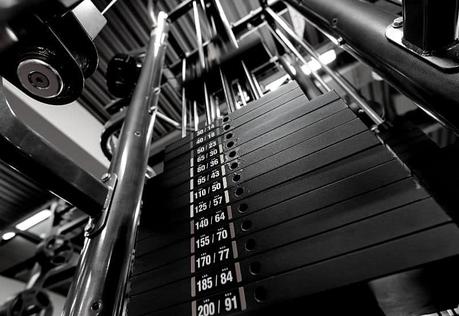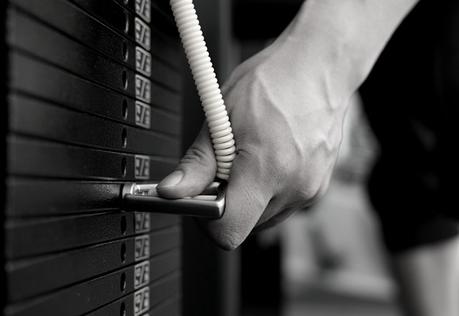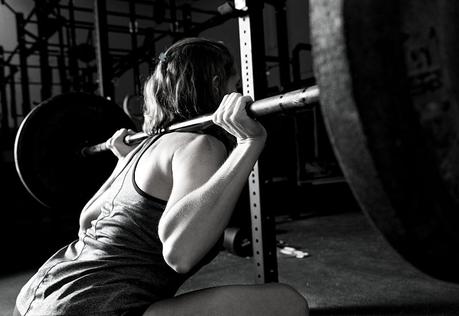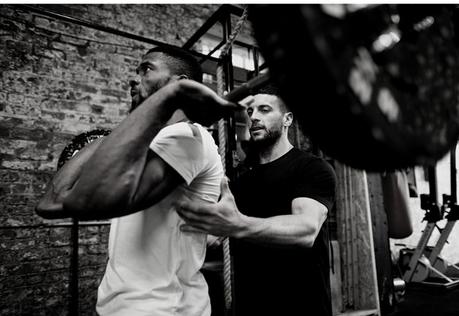Looking to get into strength training but confused by all the terminology and fancy-pants lingo? This comprehensive guide breaks down the most common terms and concepts so you can confidently hit the gym and start getting those gains.

If you’re just getting into strength training, you’re probably hearing a lot of complex-sounding terms thrown around.
Some are easy to understand: reps and sets aren’t too complex, and you can figure out what people mean when they talk about “cardio conditioning” and “building power”.
Some, however, are a bit harder: what the heck is “1RM”, a “drop set”, and how can any kind of contraction be “eccentric” (or “concentric”, for that matter)?
Yes, like everything else, the world of strength training is filled with lingo that can sound complicated at first, but which can actually be fairly easy to learn.
Below, you’ll find a comprehensive list of some of the most common terms you’ll hear at the gym, the standard strength training terminology you’ll need to know to conquer your strength training workouts.
Strength Training Terminology
Let’s dive right in and take a closer look at all these important terms you need to know:
Reps
Reps, or “repetitions”, refers to the number of times you perform a single movement in a set (see below). For example, a “set of 12 reps” means you complete 12 repetitions of the movement.
Sets
Sets are the specific number of repetitions you perform before you rest. Typically, you will perform multiple sets of each exercise—for example, 3 sets of 12 reps of Bench Press—before moving on to the next exercise.
Weight/Resistance
This is an easy one: this is the amount of weight you’re lifting (in kg/lbs.) or the resistance you’re working against (either in kg/lbs. or a specific number setting on a cardio machine). The more weight you lift, the more you build strength and power. The less weight you lift, the more you build endurance.
Typically, fewer repetitions are performed of high-weight exercises, while more repetitions of low-weight exercises are performed.

Rest
Your body can only sustain exertion for so long before it needs to rest. With weightlifting, you are continually engaging the muscles, which burns through oxygen and ATP energy while also flooding them with lactic acid. Your body needs a rest period in order to flush out the lactic acid and replenish both the oxygen and spent energy.
How long you rest will depend largely on the exercise. For more endurance-focused workouts, your rest will likely be in the 30 to 60-second range.
For more power-focused workouts, your rest between sets can stretch from 1 to 5 minutes. For high-intensity interval training, rest periods will typically be between 10 seconds (for Tabata) and 120 seconds (the longer range of HIIT rest intervals).
Volume
Volume is calculated using the following formula:
Weight lifted x sets x repetitions = volume.
For example, if you’re bench-pressing 100 pounds, for three sets of 10 repetitions, your “volume” is 3,000 pounds.
Volume is a metric more advanced weightlifters use to calculate the overall effectiveness of their workouts.
For example:
Previously, a lifter was able to perform 3 sets of 10 reps bench-pressing 100 pounds, for a workout volume of 3,000 lbs. When they raise the weight lifted to 120 pounds, they were only able to perform 3 sets of 8 repetitions. Using the formula above (120 x 3 x 8), their workout volume at this new weight decreased slightly to 2,880 lbs. However, if they were able to perform 2 sets of 10 reps and only 8 on the final set, their workout volume would increase to 3,360 lbs.
Concentric Phase
Also known as the “positive phase”, this is the part of the movement where your muscles contract to either pull the weight toward you (for pull movements like pull-ups or bicep curls) or push the weight away (for push movements like bench presses and dips). It’s the more strenuous phase of the workout, the part that contributes to around 80% of your muscular growth.
Eccentric Phase
Also known as the “negative phase”, this is the part of the movement where your muscles work to return the weight to your starting position.
Your muscles are elongating rather than contracting, but they are still engaged through the full range of motion to return to your original position. This part contributes to around 20% of your muscular growth.
Sticking Point
This is the part where you get stuck in any exercise you’re doing.
For example, with pull-ups, you may find that you get stuck just before your elbows reach a 90-degree angle. Or with bench presses, your movement will stall when the weight is roughly 75% of the way back up to its starting point with your arms at full extension.
Every exercise has a “sticking point”, and you’ll likely hit it once you’re approaching muscle failure. You’ll usually need a spotter to help you complete the repetition/s safely.

Muscle Failure
Muscle failure refers to the point when your neuromuscular system is unable to produce sufficient force to contract concentrically.
For example, with a pull-up, you reach a point when your back, shoulder, and biceps muscles just can’t generate enough force to pull your body weight up toward the bar, and you get stuck at the sticking point.
Current research holds that you should be within 2-5 reps of muscle failure on every set in order to see maximum growth. That means lifting enough weight that on your initial sets, you can feel your muscles growing tired but don’t quite give out. On your last 1-2 sets, though, you want to hit muscle failure (or just short of it).
Anaerobic Exercise
Anaerobic exercise is any exercise that forces your body to produce energy without oxygen. In an “anaerobic state”, your muscles are forced to use glucose for fuel.
Typically, this involves high-intensity exercise (such as lifting heavy weights without rest or sprinting at full speed) and can only be sustained for a short period (up to 60 seconds) before your body needs a rest to flush lactic acid and absorb oxygen.
Aerobic Exercise
Aerobic exercise is any exercise that allows your body to absorb sufficient oxygen into your bloodstream to burn both glucose and fatty acids for energy. Typically, this involves lower-intensity exercise (such as jogging or cycling) and can be sustained for much longer periods (up to hours, as evidenced by marathon runners) before needing rest.
Isolation/Single-Joint Exercises
Isolation, or single-joint, exercises use just one joint and isolate a single muscle or muscle group. For example, bicep curls only use the bicep muscles, and only the elbow joint moves to perform the exercise.
These exercises are excellent for focusing on building strength in individual body parts.

Compound/Multi-Joint Exercises
Compound, or multi-joint, exercises use multiple joints and multiple muscle groups. For example, a pull-up uses the upper back, shoulders, biceps, and forearms, with the shoulder, elbow, and wrist joints all moving through the exercise.
These exercises are excellent for building overall greater strength and burning large amounts of energy.
Endurance
Endurance is defined as “a moderate amount of strength being utilized for a long period of time”. For example, holding a 1-pound weight for an hour. The muscular force (strength) being utilized is minimal, but is sustained for a long period of time.
Power
Power is defined as “a significant amount of strength being utilized for a short period of time”. For example, bench-pressing 300 pounds for a set of 2-3 reps. The muscular force (strength) being utilized is significant (fairly close to maximum, in fact), and so can only be sustained for a short period of time.
Explosive Strength
Explosive strength refers to the ability to exert a maximum amount of force in a minimum amount of time. This “maximal force” is necessary to, for example, propel you off the ground when you jump.
Exercises that train explosive strength, like jump squats and other plyometric exercises, therefore, often involve jumping movements, or force production that is very near maximum.
Body Part Split
This refers to how you divide the various muscle groups in your body into different workouts.
My personal body part split is:
- Day 1: Chest, Triceps, Abs
- Day 2: Upper Back, Biceps, Lower Back
- Day 3: Legs
- Day 4: Shoulders, Traps, Obliques, and Forearms
You see, with a body part split, you never work the same muscles/muscle groups on consecutive days. Your body needs 48+ hours of rest after an intense strength training session in order to sufficient replenish lost energy and repair damage to the muscles and joints.
Splitting up the body parts in this way ensures sufficient rest time between training.
1-Rep Max
Also written as “1RM”, this refers to the amount of weight you can lift for a single repetition, which could be the maximum amount of weight you’re capable of lifting. Typically, you work at a percentage of your 1-Rep Max weight. The higher the percentage, the more you’re working for power. The lower the percentage, the more you’re working for endurance.
For example, if you can perform 1 repetition of 200 pounds on the bench press, you’d work at 85% 1-Rep Max (or 170 pounds) to build power, or 65% of 1-Rep Max (or 130 pounds) to build endurance.
Absolute Strength
Absolute strength refers to the total amount of force your muscles are capable of generating in a single contraction (usually in “involuntary” conditions).
The average person can only ever tap into around 65% of their absolute strength, though more experienced strength trainees may be able to access around 80% of their absolute strength.
Really, absolute strength is only ever accessed in extreme or emergency situations, when your brain floods your body with chemicals (such as adrenaline and cortisol) and actually overrides the “fail-safes” it has in place to protect your joints and muscles from over-exertion that may cause damage.

Spotter
A spotter is someone who helps you safely complete a set of repetitions. They may provide assistance if you are unable to complete the set, or merely stand by ready to aid you if you’re not certain you will be able to manage all the repetitions.
A spotter will help you get past the “sticking point” and hit muscle failure safely without mechanical failure (your bones, muscles, and joints moving incorrectly to complete a difficult set).
Superset
There are actually two types of supersets:
- Agonist superset, which involves performing two exercises that target the same muscle with very little or no rest between. For example, performing a set of bench presses then dropping down to perform a set of push-ups would be considered an agonist superset.
- Antagonist superset, which involves performing two exercises that target opposing muscle groups with very little or no rest between. An example would be performing a set of bench presses to target your chest, then following it up with a set of pull-ups to target your upper back.
Supersets increase aerobic demand on your body, and decrease overall training time.
Hypertrophy
Hypertrophy is the correct medical term for what we call “muscle growth.” It refers to an increase in both size and number of the muscle cells, enabling your muscles to store more energy and thus be capable of generating more force.
Progressive Overload
This is a technique used to encourage continual increases in not only muscle strength and endurance, but also muscle size. It is a combination of:
- Increasing weight/resistance
- Increasing workout volume (reps and sets)
- Decreasing the duration of rest between each set
- Increasing the frequency of training that specific muscle or muscle group
High Intensity Interval Training (HIIT)
This is a form of training that involves periods of high (or maximum) intensity effort interspersed with periods of low intensity effort. This increases the demands placed on your cardiovascular system, so you burn calories more quickly, and shortens the rest time between sets so you complete your workouts faster.
Drop Sets
Drop sets are considered a more “advanced” technique, one intended to help you hit muscle failure and trigger hypertrophy.
With drop sets, you start off with your normal (or a heavier-than-normal) weight load, and complete as many repetitions as it takes to hit muscle failure. Immediately, with no rest, you reduce your weight load (by 5-15%) and repeat the exercise with the lighter weight until you hit muscle failure again.
This is a highly intense training technique that can increase hypertrophy significantly, but may also increase injury risk. Make sure you have a spotter standing by!
The Bottom Line
These are just a few of the many, many strength training terms that you’ll run into on your muscle-building journey.
Each one will play an important role in your understanding of how best to approach your training, how to make the most of every minute you spend in the gym.
Weightlifting and strength training can be amazing for your health—improving brain function, developing greater mobility, boosting your strength, and making you more resilient to injury—so it’s worth learning these (and the many more) terms!
More Guides Like This
Best Weightlifting Books: Essential Reading for Crushing the Gym. Looking for a blueprint for better workouts in the gym? Here are the essential weightlifting books to get you started.
